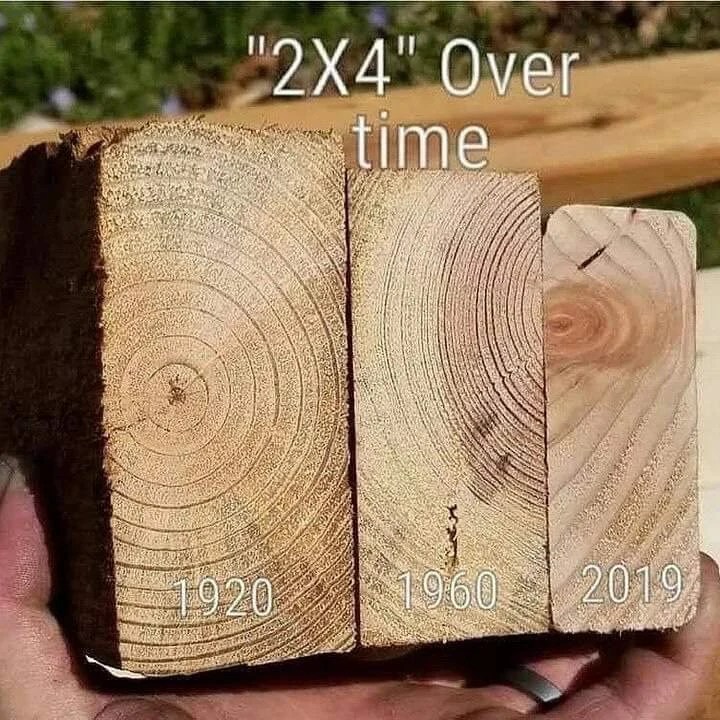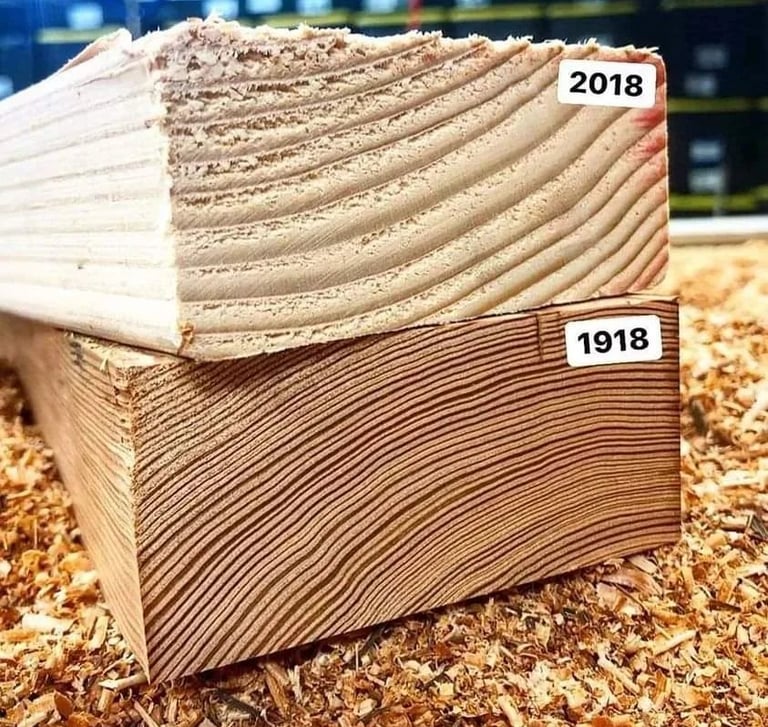How the Quality and Size of 2x4 Lumber Has Changed Over Time
The image above visually highlights the transformation of lumber standards over the years — from 1920, 1960, to 2019.
ARTICLES
12/16/20242 min read


What stands out is how the size and quality of the lumber have changed over the years. Let’s break down why this has happened and why older wood was of superior quality.
Why Was Lumber Better in the Past?
1. Mature Trees
In the early 20th century, lumber was cut from mature, slow-growing trees. These trees had tighter annual rings (growth rings), which directly contributed to their strength and density. The slower a tree grows, the denser and stronger its wood becomes.
2. Bigger Standards
Originally, “2x4” referred to the actual measurements of the lumber: 2 inches by 4 inches. By 1960, the industry began standardizing the dimensions to a smaller size, factoring in planing and smoothing the wood. This led to “nominal sizing,” where a 2x4 was closer to 1.5x3.5 inches in actual size.
3. Quality and Processing
Earlier lumber was processed with fewer industrial pressures. Trees were allowed to grow naturally, and the wood had fewer defects like knots and splits. Modern lumber, in contrast, is often sourced from fast-growing, younger trees, which results in weaker wood with more imperfections.
Why Have Standards Changed?
1. Demand for Wood Increased
The rapid growth of construction, especially after World War II, led to a higher demand for lumber. To meet this demand, industries began cultivating faster-growing trees like pine, which mature quickly but lack the density of old-growth timber.
2. Industrial Efficiency
The lumber industry shifted towards mass production and efficiency. Wood was cut, planed, and treated faster to reduce costs. This resulted in smaller dimensions and reduced quality.
3. Cost Reduction
Using smaller, faster-grown trees allows lumber to be produced at a lower cost. While this benefits construction budgets, it compromises long-term strength and durability.
Why Does Wood Age Matter?
The age of the tree directly impacts the wood’s quality. Mature trees have tighter growth rings due to slower growth, making the wood:
• Stronger – It can handle more weight and pressure.
• More Durable – Resistant to warping, shrinking, and splitting.
• Long-Lasting – Ideal for construction projects that require longevity.
In contrast, modern wood sourced from younger trees has wider growth rings and less density, making it more prone to damage and wear over time.
Conclusion
The evolution of wood size and quality reflects changes in industry standards, demand, and cost-saving measures. While older lumber was stronger and more durable, modern construction methods require careful material selection to ensure quality and longevity.
If you’re planning a construction project and need advice on choosing the right materials or reliable services, ProHands Handyman is here to help. We focus on delivering high-quality craftsmanship with durable materials that stand the test of time.
📞 Contact Information:
• Phone: 818-401-7766
• Website: www.prohandshandyman.com
• Service Area: Glendale, Burbank, Pasadena, and surrounding areas
Contact us today to start your next project and receive a free consultation!


